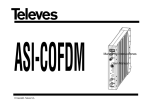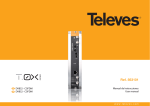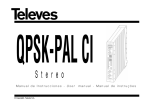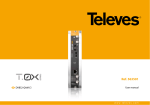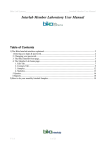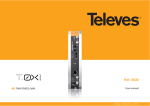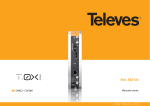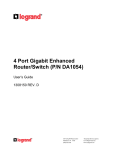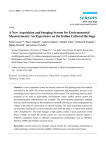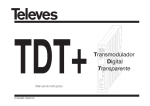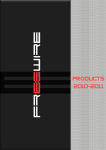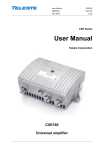Download Refs. 563101, 563301
Transcript
Refs. 563101, 563301 EN DVBS2 - COFDM / COFDM CI User manual w w w. t e l e v e s . c o m DVBS2 - COFDM / COFDM CI Index 5 7 8 8 9 10 10 11 12 13 14 14 16 18 19 20 22 23 25 A. Channels table ..................................................................................................................................... 27 EN ENGLISH 1. Technical specifications . ..................................................................................................................... 2. Reference description . ........................................................................................................................ 3. Mounting . ............................................................................................................................................ 3.1. Wall mounting ............................................................................................................................... 3.2. 19” rack mounting ....................................................................................................................... 4. Element description ............................................................................................................................. 4.1. Introduction ............................................................................................................................... 4.2. Power supply unit ...................................................................................................................... 4.3. Amplifier ................................................................................................................................... 4.4. Universal programmer .............................................................................................................. 5. How to use the product ....................................................................................................................... 5.1. Main menu ................................................................................................................................ 5.2. Extended menu . ........................................................................................................................ 5.3. Parameters saving ..................................................................................................................... 6. Selecting the DVB-T output mode in DVBS2-COFDM (CI) transmodulators ..................................... 7. Controlling the device ......................................................................................................................... 8. Distribution of 7 channels of DVBS2-COFDM (CI) T0X ....................................................................... 9. Norms for rack mounting . ................................................................................................................... 10. Norms for cabinet mounting . .............................................................................................................. 5 1. Technical characteristics 1.1. DVBS2-COFDM ref. 563101, DVBS2-COFDM CI ref. 563301 RF output General Through loss < 1,5 dB typ. Symbol rate Modulation DVB-S2 (QPSK, 8PSK) DVB-S (QPSK) Frequency steps 1 MHz Internal FEC LDPC (9/10, 8/9, 5/6, 4/5, 3/4, 2/3, 3/5, 1/2) Input/Output connectors “F” female External FEC BCH (Bose-Chaudhuri-Hocquenghem) Input impedance 75 ohm. Roll-off factor 20%, 25%, 35% LNB power supply 13/17V/ OFF 22KHz (ON/OFF) Input VSWR 10 dB min. Modulation format QPSK, 16QAM, 64QAM Scrambling DVB ET300744 Guard interva 1/4, 1/8, 1/16, 1/32 Interleaving DVB ET300744 FEC 1/2, 2/3, 3/4, 5/6, 7/8 Cell_id Selectable Bandwidth 7 MHz, 8 MHz Output spectrum Normal / Inverted (Selec.) Output frequency 177 - 266 / 474 - 858 MHz (CH mode) 45- 862 MHz (frequency mode) Through loss < 1,5 dB typ. Frequency steps 125 / 166 KHz Return loss > 12 dB typ. Maximum output level 80 ±5 dBμV (progr.) Input/Output connectors “F” female. Attenuation >15 dB (prog) Output impedance 75 ohm. Consumption @ 24V (with signal)* Protection index IP20 270 mA (LNB power OFF) 480 mA (LNB power ON) 563301 COFDM Modulator 950 - 2150 MHz 10 - 30 Mbaud DVB-S2 (QPSK - 8PSK) 2 - 42,5 Mbaud DVB-S (QPSK) 563101 Satellite Demodulator Input frequency 280 mA typ. (no CAM inserted; LNB power OFF) 330 mA typ. (CAM inserted; LNB power OFF) 500 mA typ. (no CAM inserted; LNB power ON) 540 mA typ. (CAM inserted; LNB power ON) * The unit’s consumption with CAM will depend on the type of CAM being used (only ref. 563301). For the LNB it is considered a standard consumption of 300 mA. The technical characteristics described are defined for a maximum ambient temperature of 45°C (113ºF). Forced ventilation is used for higher temperatures. EN DVBS2 - COFDM / COFDM CI 6 1.2. Technical specs. Broaband Amplifiers Amplifier 5575 Amplifier 451202 (1) Main channel Frequency range 46 ... 862 MHz Connector Gain 44 ± 2,5 dB Power supply “F” 24 V Regulation margin 20 dB Consumption at 24 V 450 mA Output level (60 dB) 105 dBµV (42 CH CENELEC) Test socket -30 dB Frequency range (1) 47 ... 862 MHz Connector “F” Gain (1) 40 - 53 dB (selec.) Power supply 196 - 264 V~ 50/60 Hz Maximum output level (1) 129 dBµV (typ.) (DIN 45004B) Max. Power 16 W Frequency range (2) 5 ... 30 MHz Test socket -20 dB Gain (2) 20/ -3 dB (typ.) Maximum output level (2) 129/ --- dBµV (typ.) (DIN 45004B) (2) Return channel (active/passive) 1.3. Technical specs. Power Supply Unit Power supply unit 5629 Mains voltage 196 - 264 V~ 50/60 Hz Total max. current (outpur 1 + output 2) 5A (24V ) Output voltage 24V Max. current per output 4A ) (24V 1.4. Blocks Diagram only ref. 563301 CAM INPUT SAT DVB-S DVB-S2 Demodulator Interfaz CI TS processing COFDM Modulator Up Converter OUTPUT TDT 7 2. Description of references Product Range Accessories 563101 T-0X DVBS2-COFDM 7234 Universal Programmer 563301 T-0X DVBS2-COFDM CI 5071 T03-T05-T-0X Mounting rail (50 cm) 5575 Broadband Amplifier 44dB 120dBµV T-0X 5239 T03-T05-T-0X Mounting rail.12 Modules+PSU (56 cm) 451202 Amplifier DTKom (47 - 862 MHz) 5301 19” Subrack frame 5559 Headend Manager CDC-IP T-0X 507202 T-0X Lockable cabinet with Ventilation Unit (7 Modules + PSU) 555901 Headend Manager CDC-IP GSM T-0X 4061 75 Ohm DC-Block load 5629 Power supply unit 24VDC/5A T-0X 4058 75 Ohm Load 422601 T05 to T-0X Power connection lead (40 cm) 422602 T05 to T-0X Management connection lead (40 cm) 422603 T-0X Management connection lead (1m) 5673 Blank plate 50 mm EN DVBS2 - COFDM / COFDM CI 8 3. Mounting 3.1. Wall mounting IF satellite input 5629 563101, 563301 5575 5071 5239 CLAC! Output COFDM 4061 7234 NOTE: The use of both source outputs is recommended, balancing the consumption. For example, 4+3 or 3+4 modules 5301 9 3.2. 19” rack mounting EN DVBS2 - COFDM / COFDM CI 10 4. Identification of the system elements 4.1. Introduction Ref. 563301 1. IF satellite input 2. IF satellite output 3. RF input 4. RF output 5. Module power supply input 6. Status LED 7. Control BUS connector 8. Input to insert CAM (only ref. 563301) 9. Programmer / PC connector Ref. 563101 The DVBS2 transmodulator with COFDM CI receives a satellite transponder in some DVBS (QPSK) or DVBS2 (QPSK or 8PSK) modulation formats and demodulates it by obtaining an MPEG-2 transport package. The MPEG2 transport package is then modulated in COFDM format and converted to the output Ref. 563301 channel (UHF or VHF and with a maximum bandwidth of 8 MHz) using an agile up-converter. Additionally, ref. 563301 incorporates a Common Interface slot for inserting a conditional access module (CAM) to permit the unscrambling of services. Insert the smart card completely into the CAM slot before powering modules. Card contacts looking left and forwards when it is being inserted. The programming of the transmodulator operating parameters (input frequency, output channel, modulation format and adaptation of services mainly) is performed through the universal programmer (ref. 7234). 11 4.2. Power supply unit (1) Connectors to power the modules (1) EN GND On LED 24V: OK 0V: Overload or short circuit Mains input 230V~ NOTES: - The power source can supply a maximum of seven DVBS2-COFDM (CI) T0X modules. - Whenever the demand of power exceeds 4A (max. current for each output), it is necessary to distribute it between the two powering outputs of the PSU. DVBS2 - COFDM / COFDM CI 12 4.3. Broadband amplifier OPTION “A” - 5575 OPTION “B” - 451202 1. RF output 2. Test socket (-30 dB) 3. RF input 4. RF input 5. Powering BUS connectors 6. Status LED 7. Gain attenuator It features two input connectors, to allow mixing of channels coming out from two different systems. If only one of the inputs is used, it is recommended to load the unused input with a 75 ohm terminator, ref 4061. As the rest of T-0X units, this amplifier is powered via the 24 Vdc power BUS. 1. Mains power supply input (196-264 V~ 50/60 Hz) 2. Ground connection 3. Power LED 4. MATV input Return channel output 5. MATV input test 6. MATV output test 7. MATV output Return channel input The broadband amplifier amplifies the channels generated in the transmodulators, covering the frequency margins from 47 to 862 MHz 13 4.4. Universal Programmer PCT 5.0 The programmer consists of 4 buttons: (short press) - Selection of parameter (positioning of the cursor). - Modification of the parameter chosen by the cursor (flashing) (short press) - Change menu (long press) - Change between Principal and Extended menus (long press) - Save changes to memory + Cloning menu. + + Increases the contrast of the screen. + + Decreases the contrast of the screen. EN DVBS2 - COFDM / COFDM CI 5. - Instructions for use 14 5.1. Normal menu In case of selecting 0V, the selection of satellite is disabled while selecting a satellite from 0V it will change automatically to 13V (is not possible select DiSEqC with 0V power supply). Insert the programmer in the front connector of the module programming (“PRGM”). First, the a. Input menu programmer’s firmware version will appear: In case of a ‘short-circuit’ in the input connector The first main menu lets you select the input (power supply enabled for the LNB) the LED on frequency, the symbol rate of the input signal the front of the module flashes until this condition and the power supply of the LNB converter disappears. and it allows the selection of satellite using DISEqC. The firmware version of the DVBS2 – COFDM CI module is shown below: b. To make a change press the key until the desired parameter flashes. This field can be then be changed by means of the keys and . COFDM1 modulation menu The next main menu allows various COFDM output modulation parameters to be selected: The range of values allowed for the input frequency is 950-2150 MHz, whereas for the symbol rate the range is 2 to 42.5 Mbaud for DVB-S and 10 to 30 By pressing + , you access the “cloning” The parameters that can be selected in this menu Mbaud for DVB-S2. functions, through which you can copy the and their possible values are as follows: configuration of the transmodulator into the DiSEqC settings: It allows to select a satellite Remote Control Unit and, in the same way, •B andwidth of the COFDM signal: 7MHz or from four possible (A, B, C and D) through DiSEqC download this configuration from the Remote 8MHz. commands, for example when the input of the unit Control Unit to the transmodulator. • Modulation: QPSK, 16QAM or 64QAM. is the output of a multiswitch. In the remote control unit manual you will find a • Guard interval: 1/4, 1/8, 1/16 or 1/32. decription of the cloning functions. • FEC: 1/2, 2/3, 3/4, 5/6 or 7/8. LNB power: The possible values for the power of the converter are: 0V, 13V, 13V 22KHz tone, 17V, 17V 22KHz tone. The tone is represented with the symbol “~”. 15 c. COFDM2 modulation menu In the next main menu you can select the parameter cell_id (cell identifier) of the COFDM modulation: d. Output menu The next main menu shows the frequency or output channel, the output offset (only in channel mode), the level control and the selection of output spectrum inversion. To change the frequency press the key until the desired parameter flashes. This field can be then be changed by means of the keys and . In frequency mode you can select any output frequency value between 45 - 862 MHz. The decimal part depends on the difference of frequency chosen (see extended menu b). If you select a difference of 125 KHz the permitted values for the decimal part are 0, 125, 250, 375, 500, 625, 750 and 875 KHz. With a difference of 166 KHz the possible values are 0, 166, 333, 500, 666 and 833 KHz. The output level control permits values between 00 and 99. The possible values for the output spectrum inversion are “Norm.” (not inverted) and ‘Inv.’ (spectrum inversion). In channel mode it lets you select an output channel from the table selected as well as the offset regarding the channel’s receiving point frequency. The permitted offset values depend on the frequency difference selected (see configuration menu): • Steps of 125KHz: ±4 (-500, -375, -250, -125, 0 , 125, 250, 375, 500 KHz) • Steps of 166KHz: ±3 (-500, -333, -166, 0 , 166, 333, 500 KHz). e. Service menu This menu shows the list of transport stream services selected. Each time the user selects a new SERVICIO input transport, the unit performs a search for the services. Scanning: 13 During that process the unit will display the following message, indicating the number of services found: SERVICE Scanning: 13 Once the search is complete, it shows the list of services with the following information: PROGRAMME Einzulesen:13 SERVICE The service order number as well as the total Recherche:13 number of services in the multiplex (in service figure 2 of 8 available) are indicated, the statistics (in the figure 18/25), the name of the service and if the user has selected it for removal in the output (OFF) unscrambling (DCY) or to move it to output without changingSERVIZIO (ON). The meaning of Ricerca: the statistics13 is as follows: the first number indicates the percentage of the output EN DVBS2 - COFDM / COFDM CI that occupies the service indicated. The second number indicates the percentage of the output that is free. In the example, France 2 will occupy 18% of the output (it is OFF so it is removed) and there is 25% of free space. It is easy to see that, in principle, this service could be activated (ON or DCY) because there is still sufficient capacity to output. The free percentage to output is only updated once the configuration of the services has been recorded. Additionally, the status (scrambled or clear) of the service, both at the input and output are indicated in the upper right hand corner: Scrambled service at input and output. Scrambled Service at input and clear at output. Scrambled service at input. 16 g. Measurements menu 2 This menu indicates the occupancy rate of the module’s output as well as the maximum achieved. If too many services are selected it will result in an output overflow and this condition is indicated. Occupancy values higher than 82% are not recommended. This is a read only menu, which disables the keys and . You can reset the maximum occupation by . pressing the key 5.2. Extended menu When the key is held down for more than 3 seconds the unit shows a series of less frequently used menus called extended menus. a. Configuration menu 1 This menu enables the address of the unit to be selected (to be controlled through a CDC Headend Control). It also allows selection of the output frequency difference (125 or 166KHz), the table of channels to use or frequency mode operation. f. Measurements menu 1 The following menu provides an indication of the input signal quality using an estimate of C/N (dB) and the link margin (dB). The channel tables that can be selected are: • CCIR, • China • Chile • Italy • France • OIR channels • Ireland • South Africa • Poland • Australia 17 b. Configuration menu 2 Next menu allows you to select the version of the output NIT and the type of LCN (Logical Channel Number). NIT’s version can be selected between 0 and 31 or “AUT”, in which case the output NIT will have the same version as the input. You can choose Auto mode (the identifiers do not change) or Manual mode. When switching from Auto mode to Manual the identifiers received by satellite are displayed and the user can change them. If the maximum recorded is outside the optimal range the installation should be adjusted to try to lower the temperature. If the DVBS2-COFDM (CI) modules have been installed in a housing ref. 5069 and the temperature of one of the modules is outside of the optimal operating range, the ventilation unit will have to be installed ref. 5334. To check whether this change is effective the maximum can be reset and its value checked after a given time. Regarding the Logical Channel Number (LCN), no all receivers understood in the same way this information. Some countries use some variation on the standard to be applied to this configuration to work properly. Possible values are Generic, UK, Nordig 1, Nordig 2. c. Identifier menu Some DVB-T receivers can present problems receiving transmodulator channels which share the same identifier (transport_stream_id). To avoid these cases the user can change the following DVBT output multiplex identifiers: transport_stream_id (ts_id), network_id (n_id) and original_network_id (on_id). d. T emperature measurement MEDIDAS menu Act: Max: 04 05 The following menu provides an indication of reset the unit’s current temperature as well as the maximum recorded. The maximum can be reset by pressing the key . MONITOR Now: 04 Max: 05 reset e. Versions menu In this menu the user is shown the firmware versions for the unit and the COFDM (FPGA) modulator. The recommended operating margins are as follows: MESSUNGEN • Optimum operation : 0-6 Akt: 03 Max: 7-8 04 • High temperature: reset • Excessive temperature: 9-10 f. CAM (MMI) user interface menu (only ref. 563301) This menu allows access to the conditional access module (CAM) user interface, for example, to check versions or card rights: EN DVBS2 - COFDM / COFDM CI 18 output for each of the configured services to ON / DCY. Using this option you can change a service by another previously to OFF and keep on the same service id, allowing that a large number of receivers to detect the change automatically without the need to re- scan. g. LCN menu Assign a LCN (Logical Channel Number) (between 1 and 1023) to the existing services at the output (marked as ON or DCY). To change the LCN press keys and select “0000” as LCN will show “NO LCN”. or . If When it is detected that the LCN displayed value is assigned to more than one service remind admiration (!) to the left of the value, will be displayed to indicate to the user that must assign other LCN. At the top of the screen shows the index (order) of the current service and the total number services present in the output. Then is the name of the service and finally, on the bottom line of the screen, the corresponding number with the service id original and the value of service id in the output. It is user’s responsibility to avoid setting the same SID for different services. When detects that tje shown SID value is assigned to more than one service or the value is 0, will be displayed a symbol of admiration (!) to the right of the value, to indicate to the user that should change it. i. Language menu h. Remapping menu of service_ids This menu allows to set the value of the service id The last extended menu enables the menu language to be selected (Spanish / English / German / French / Italian): Pressing keys language. and changes the selected 5.3. Parameters saving Grabando los Parametros y rearrancando Once a parameter is modified to the desired value ... in any menu (normal or extended), to save the settings press for three seconds. The display will show the following indication: Saving settings and restarting ... If the configuration paremeters are modified but not saved, the previous configuration is retrieved after 30 sec. inParameter other words, the changes are discarded. gespeichert & gestartet ... Sauver les 19 6. - S electing the DVB-T output mode in DVBS2-COFDM (CI) transmodulators The standard DVB-T defines various possible operation modes which enable the DVB-T signal generated to adjust to the conditions of the transmission channel. The signal for instance can travel through a very noisy channel (low C/N) but will bring with it reception errors. The signal may also reach the receiver through a number of paths, one main path and another or various secondary ones (ECHOES). Put simply, we could say that the DVB-T operation modes can be characterised by the following: NOTE: We suggest choosing one of the DVBT modes from the chart. Those modes which have not been included have a lower information service output. 1 - Type of modulation 2 - Level of protection against Errors 3 - Level of protection against Echoes In the following chart, one can see a subgroup of the possible DVB-T modes that indicates the information service output (Mbits/s) that each one can transmit. The greater the information service output of the DVB-T mode selected, the greater the number of TV and Radio services which can be transmitted through the signal. Information service output (Mbits/s) for DVB-T signals with a 64QAM modulation in 8MHz channels. One the right hand side of the chart are the different unit step functions (64 QAM 2/3, 64QAM 3/4, 64QAM5/6, 64QAM 7/8), each one corresponds to a degree of protection against errors which the DVB-T signal can carry. We will now look at the level of protection against echoes. To do so, one must select one of the four possible vertical axes that appear on the left side of the previous chart (GI=1/4, GI=1/8, GI=1/16, GI=1/32). The higher the step selected, the greater the information service output (Mbits/s) of the relevant DVB-T mode, although it´s level of protection against errors will be inferior and it will require a higher C/N to receive the signal. The further left the selected axis is, the greater the DVB-T mode´s information service output (Mbits/s) will be, but its level of protection against echoes will be lower, in other words, the maximum supported echo delay will be inferior. EN DVBS2 - COFDM / COFDM CI 20 In short, the higher and further to the left the DVBT mode selected is, the more powerful this mode will be in terms of information service output (Mbits/sg). On the other hand, the lower and further to the right the DVB- T mode selected is, the more robust this mode will be in terms of interferences which could affect the signal. Given that our transmission channel is better, we can use the DVBS2-COFDM (CI) transmodulator, by selecting a higher DVB-T output mode than that used by terrestrial channels to disseminate. This will have a greater information service output (Mbits/s) and will therefore enable us to include a greater number of TV and Radio services. The terrestrial transmission channel (transmission aerial - terrestrial atmosphere – receiving aerial) is very complex, with numerous interferences that can potentially affect the DVB-T signal. Therefore, when setting up the DVBS2- COFDM (CI) transmodulators, one should follow a procedure such as the one below: Due to this, in Spain, the DVB- T signal is generally disseminated with the following features: (1) Type of modulation: 64QAM (2) Level of protection against Errors: 2/3 (3) Level of protection against echoes: 1/4 If one looks at the previous chart, one can see that the information service output of the DVB-T mode is 19.91 Mbits/s. In our case, the DVB-T signal generated by the DVBS2-COFDM (CI) transmodulator, is not going to be transmitted through the terrestrial transmission channel, but through a channel that is generally much more benign: the distribution network of the building. NOTE: The better the quality of the building´s distribution network, the better the transmission channel will be when transmitting signals. 1 - Select one of the stronger DVB-T output modes. E.g. 64QAM-5/6 with GI=1/32, information service output of 30.16 Mbits/s. 2 - Check the quality of the signal received at various points within the building. If the signal quality is good, the technician can consider using an even stronger DVB-T mode, in other words, one with a greater information service output. On the other hand, in cases where the signal quality is insufficient, they must consider using a more robust DVB-T mode. In most cases, the distribution network within the building should support those DVB-T modes that have a lower protection level against echoes. Therefore, if a more robust mode is necessary, one should first try using, one at a time, greater protection levels against errors. 7. - Controlling the Device This version of the DVBS2-COFDM (CI) T0X allows configuration and monitoring via a PC, both locally and remotely. a. Local control You need to have the TSuite software package (version v2.1.4.x32 or higher), as well as a special cable (provided with the programme) that connects a PC serial port to the DVBS2-COFDM (CI) T0X “PRGM” connector. The programme can be used to set up and read all the operating parameters, as well as to monitor the correct operation of the device. b. Remote control It is necessary to have a Headend Control module (ref. 555901) that includes the programme mentioned above, and the corresponding modem connected to a phone line. Once the communication with the headend control has been established, all the controllable devices that have been installed in the headend can be accessed. In this case it is essential that each element be programmed with a different device address between 1 and 254. 21 Menu structure Long press EN MENU “ ” (*) EXTENDED MAIN MENU ¡ (*) Only ref. 563301 DVBS2 - COFDM / COFDM CI 22 8. Application example Distribution of 7 channels of DVBS2-COFDM CI T0X 75 ohm 4061 4512 5629 7 x 563101/563301 COFDM output The diagram shows the assembly for the distribution of 7 channels of DVBS2-COFDM (CI) T0X 23 9. Norms for rack mounting (max. 35 DVBS2-COFDM (CI) T0X - 7 subracks with 5 units in height - 8,7”) 9.1. Installation of the rack with ventilation facilities To facilitate the renewal and circulation of the air inside the rack, and the temperature of the units and thus improve their characteristics, it is advisable to place 2 ventilation units of 25W, particularly when the rack with the DVBS2COFDM (CI) T0X is located in warm place, with a temperature higher than 45°C. These ventilators will be placed on a tray, that is screwed onto the top part of the Rack, fig. 1 and 2. This way, the ventilators will force the fresh air entering from the base of the cabinet, to circulate between the modules and be expelled through a gap on top of the cabinet (3-5 cm approx.). See fig. 3. EN Frontal Subrack fig. 1 fig. 2 fig. 3 DVBS2 - COFDM / COFDM CI 24 9.2. Installation of the rack without ventilation facilities It is very important that this process operates correctly, therefore the following must be observed: - Do not open the side doors, as this would cause the ventilators to extract the air from the outside rather than the air in the inside of the rack. To install the units in racks without installation facilities, and when the rack is located in a place with a temperature of around 45°C, it is advisable to place the rack completely open, in other words, do not use the side doors. This is to facilitate the ventilation of the units , fig. 5. - Do not place objects close to the rack that may block the entry and exit points of the air. - If the rack is not complete, the subracks must be placed from the top downwards without leaving any gaps in between, fig. 4. fig. 4 fig. 5 25 10. Norms for cabinet mounting IMPORTANT The scheme of recommended ventilation is the one in the figure in any case of cabinet placement (horizontal or vertical). EXTRACTOR for forced ventilation must be onto the highest module. EN Maximum environment temperature: 45ºC. The maximum temperature permitted surrounding the highest cabinet is 45ºC in both ways of placement, horizontal or vertical way. Horizontal placement Vertical placement Inferior grid in any wall. DVBS2 - COFDM / COFDM CI 26 IMPORTANT Horizontal placement of the cabinets is strongly recommended, hanging them with as less height as possible. If the horizontal placement is impossible, then vertical placement is allowed. HORIZONTAL Respect the recommended minimum distances in the attached schemes. Place the cabinets with as less height as possible Maximum T: 45ºC. VERTICAL 27 A. Channels table Table1 Table2 Table3 Table4 Table5 Table6 Table7 Table8 Table9 Table10 CCIR China/Taiwan Chile Italy France OIR channels Ireland South-Afric Poland (OIR) Australia C05 C06 C07 C08 C09 C10 C11 C12 C21 C22 C23 C24 C25 C26 C27 C28 C29 C30 C31 C32 C33 C34 C35 C36 C37 C38 C39 C40 C41 C42 C43 C44 C45 C46 C47 177,50 184,50 191,50 198,50 205,50 212,50 219,50 226,50 474,00 482,00 490,00 498,00 506,00 514,00 522,00 530,00 538,00 546,00 554,00 562,00 570,00 578,00 586,00 594,00 602,00 610,00 618,00 626,00 634,00 642,00 650,00 658,00 666,00 674,00 682,00 7 8 9 10 11 12 C21 C22 C23 C24 C25 C26 C27 C28 C29 C30 C31 C32 C33 C34 C35 C36 C37 C38 C39 C40 C41 C42 C43 C44 C45 C46 C47 C48 C49 179,00 187,00 195,00 203,00 211,00 219,00 474,00 482,00 490,00 498,00 506,00 514,00 522,00 530,00 538,00 546,00 554,00 562,00 570,00 578,00 586,00 594,00 602,00 610,00 618,00 626,00 634,00 642,00 650,00 658,00 666,00 674,00 682,00 690,00 698,00 6 7 8 9 10 11 12 22 23 24 25 26 27 28 29 30 31 32 33 34 35 36 37 38 39 40 41 42 43 44 45 46 47 48 49 177,00 183,00 189,00 195,00 201,00 207,00 213,00 479,00 485,00 491,00 497,00 503,00 509,00 515,00 521,00 527,00 533,00 539,00 545,00 551,00 557,00 563,00 569,00 575,00 581,00 587,00 593,00 599,00 605,00 611,00 617,00 623,00 629,00 635,00 641,00 D E F G H H1 H2 C21 C22 C23 C24 C25 C26 C27 C28 C29 C30 C31 C32 C33 C34 C35 C36 C37 C38 C39 C40 C41 C42 C43 C44 C45 C46 C47 C48 177,50 186,00 194,50 203,50 212,50 219,50 226,50 474,00 482,00 490,00 498,00 506,00 514,00 522,00 530,00 538,00 546,00 554,00 562,00 570,00 578,00 586,00 594,00 602,00 610,00 618,00 626,00 634,00 642,00 650,00 658,00 666,00 674,00 682,00 690,00 L05 L06 L07 L08 L09 L10 C21 C22 C23 C24 C25 C26 C27 C28 C29 C30 C31 C32 C33 C34 C35 C36 C37 C38 C39 C40 C41 C42 C43 C44 C45 C46 C47 C48 C49 178,75 186,75 194,75 202,75 210,75 218,75 474,00 482,00 490,00 498,00 506,00 514,00 522,00 530,00 538,00 546,00 554,00 562,00 570,00 578,00 586,00 594,00 602,00 610,00 618,00 626,00 634,00 642,00 650,00 658,00 666,00 674,00 682,00 690,00 698,00 R06 R07 R08 R09 R10 R11 R12 C21 C22 C23 C24 C25 C26 C27 C28 C29 C30 C31 C32 C33 C34 C35 C36 C37 C38 C39 C40 C41 C42 C43 C44 C45 C46 C47 C48 178,00 186,00 194,00 202,00 210,00 218,00 226,00 474,00 482,00 490,00 498,00 506,00 514,00 522,00 530,00 538,00 546,00 554,00 562,00 570,00 578,00 586,00 594,00 602,00 610,00 618,00 626,00 634,00 642,00 650,00 658,00 666,00 674,00 682,00 690,00 5 6 7 8 9 10 11 C21 C22 C23 C24 C25 C26 C27 C28 C29 C30 C31 C32 C33 C34 C35 C36 C37 C38 C39 C40 C41 C42 C43 C44 C45 C46 C47 C48 178,00 186,00 194,00 202,00 210,00 218,00 226,00 474,00 482,00 490,00 498,00 506,00 514,00 522,00 530,00 538,00 546,00 554,00 562,00 570,00 578,00 586,00 594,00 602,00 610,00 618,00 626,00 634,00 642,00 650,00 658,00 666,00 674,00 682,00 690,00 4 5 6 7 8 9 10 C21 C22 C23 C24 C25 C26 C27 C28 C29 C30 C31 C32 C33 C34 C35 C36 C37 C38 C39 C40 C41 C42 C43 C44 C45 C46 C47 C48 178,00 186,00 194,00 202,00 210,00 218,00 226,00 474,00 482,00 490,00 498,00 506,00 514,00 522,00 530,00 538,00 546,00 554,00 562,00 570,00 578,00 586,00 594,00 602,00 610,00 618,00 626,00 634,00 642,00 650,00 658,00 666,00 674,00 682,00 690,00 K06 K07 K08 K09 K10 K11 K12 C21 C22 C23 C24 C25 C26 C27 C28 C29 C30 C31 C32 C33 C34 C35 C36 C37 C38 C39 C40 C41 C42 C43 C44 C45 C46 C47 C48 178,00 186,00 194,00 202,00 210,00 218,00 226,00 474,00 482,00 490,00 498,00 506,00 514,00 522,00 530,00 538,00 546,00 554,00 562,00 570,00 578,00 586,00 594,00 602,00 610,00 618,00 626,00 634,00 642,00 650,00 658,00 666,00 674,00 682,00 690,00 6 7 8 9 9A 10-o 10 11-o 11 12 S45 H21 H22 H23 H24 H25 H26 H27 H28 H29 H30 H31 H32 H33 H34 H35 H36 H37 H38 H39 H40 H41 H42 H43 H44 177,50 184,50 191,50 198,50 205,50 211,50 212,50 218,50 219,50 226,50 473,50 480,50 487,50 494,50 501,50 508,50 515,50 522,50 529,50 536,50 543,50 550,50 557,50 564,50 571,50 578,50 585,50 592,50 599,50 606,50 613,50 620,50 627,50 634,50 641,50 DVBS2 - COFDM / COFDM CI C48 C49 C50 C51 C52 C53 C54 C55 C56 C57 C58 C59 C60 C61 C62 C63 C64 C65 C66 C67 C68 C69 690,00 698,00 706,00 714,00 722,00 730,00 738,00 746,00 754,00 762,00 770,00 778,00 786,00 794,00 802,00 810,00 818,00 826,00 834,00 842,00 850,00 858,00 C50 C51 C52 C53 C54 C55 C56 C57 C58 C59 C60 C61 C62 C63 C64 C65 C66 C67 C68 C69 706,00 714,00 722,00 730,00 738,00 746,00 754,00 762,00 770,00 778,00 786,00 794,00 802,00 810,00 818,00 826,00 834,00 842,00 850,00 858,00 28 50 51 52 53 54 55 56 57 58 59 60 61 62 63 64 65 66 67 68 69 70 71 72 73 74 75 76 77 78 79 80 81 82 83 84 85 647,00 653,00 659,00 665,00 671,00 677,00 683,00 689,00 695,00 701,00 707,00 713,00 719,00 725,00 731,00 737,00 743,00 749,00 755,00 761,00 767,00 773,00 779,00 785,00 791,00 797,00 803,00 809,00 815,00 821,00 827,00 833,00 839,00 845,00 851,00 857,00 C49 C50 C51 C52 C53 C54 C55 C56 C57 C58 C59 C60 C61 C62 C63 C64 C65 C66 C67 C68 C69 698,00 706,00 714,00 722,00 730,00 738,00 746,00 754,00 762,00 770,00 778,00 786,00 794,00 802,00 810,00 818,00 826,00 834,00 842,00 850,00 858,00 C50 C51 C52 C53 C54 C55 C56 C57 C58 C59 C60 C61 C62 C63 C64 C65 C66 C67 C68 C69 706,00 714,00 722,00 730,00 738,00 746,00 754,00 762,00 770,00 778,00 786,00 794,00 802,00 810,00 818,00 826,00 834,00 842,00 850,00 858,00 C49 C50 C51 C52 C53 C54 C55 C56 C57 C58 C59 C60 C61 C62 C63 C64 C65 C66 C67 C68 C69 698,00 706,00 714,00 722,00 730,00 738,00 746,00 754,00 762,00 770,00 778,00 786,00 794,00 802,00 810,00 818,00 826,00 834,00 842,00 850,00 858,00 C49 C50 C51 C52 C53 C54 C55 C56 C57 C58 C59 C60 C61 C62 C63 C64 C65 C66 C67 C68 C69 698,00 706,00 714,00 722,00 730,00 738,00 746,00 754,00 762,00 770,00 778,00 786,00 794,00 802,00 810,00 818,00 826,00 834,00 842,00 850,00 858,00 C49 C50 C51 C52 C53 C54 C55 C56 C57 C58 C59 C60 C61 C62 C63 C64 C65 C66 C67 C68 C69 698,00 706,00 714,00 722,00 730,00 738,00 746,00 754,00 762,00 770,00 778,00 786,00 794,00 802,00 810,00 818,00 826,00 834,00 842,00 850,00 858,00 C49 C50 C51 C52 C53 C54 C55 C56 C57 C58 C59 C60 C61 C62 C63 C64 C65 C66 C67 C68 C69 698,00 706,00 714,00 722,00 730,00 738,00 746,00 754,00 762,00 770,00 778,00 786,00 794,00 802,00 810,00 818,00 826,00 834,00 842,00 850,00 858,00 H45 H46 H47 H48 H49 H50 H51 H52 H53 H54 H55 H56 H57 H58 H59 H60 H61 H62 H63 H64 H65 H66 H67 H68 H69 H70 H71 H72 H73 H74 H75 648,50 655,50 662,50 669,50 676,50 683,50 690,50 697,50 704,50 711,50 718,50 725,50 732,50 739,50 746,50 753,50 760,50 767,50 774,50 781,50 788,50 795,50 802,50 809,50 816,50 823,50 830,50 837,50 844,50 851,50 858,50 29 EN DVBS2 - COFDM / COFDM CI 30 Guarantee Televés S.A. offers a two year guarantee, beginning from the date of purchase for countries in the EU. For countries that are not part of the EU, the legal guarantee that is in force at the time of purchase is applied. Keep the purchase invoice to determine this date. During the guarantee period, Televés S.A. complies with the guarantee by repairing or substituting the faulty equipment. The harm produced by improper usage, wear and tear, manipulation by a third party, catastrophes or any other cause beyond the control of Televés S.A. is not included in the guarantee. 31 EN 563101_563301_001_EN

































